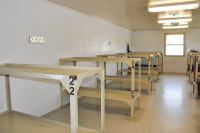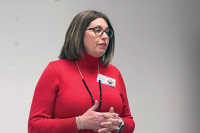Use Eagles if Necessary, Chapter 2: Why I Became a Psychoanalyst
I had become a dedicated analysand (patient) and continued to see Veryl after my wife and sons moved back to Florida. I became hooked on the process, intrigued by the simple truths it revealed, and hungered for more. I also began to harbor a secret fantasy of one day becoming a psychoanalyst, and I confided this to Veryl.
A few months later the psychiatrist/psychoanalyst and author, Jean Rosenbaum, M.D., Veryl’s husband and founder of The Institute, invited me to join the next class of candidates to begin formal training to become certified psychoanalysts. He offered to be my mentor — the highest of compliments. I was euphoric.
But the euphoria was short-lived when it occurred to me that I might first have to become a psychiatrist to become a psychoanalyst, which meant medical school. There was no way I’d be able to go back to college to get my GPA up — especially taking pre-med courses. I thanked Jean for the offer but told him I simply wasn’t smart enough to become a doctor.
He laughed and said I did not have to be a medical doctor to be a psychoanalyst and, in fact, I shouldn’t be. “Doctors are too de-sensitized by med school. They usually don’t make good analysts. It took me years to get over med school. Those cadavers...,” he sighed.
“I don’t understand,” I replied.
“Medical doctors,” Jean continued, “are electricians, mechanics, plumbers, engineers and chemists for the body. They are not trained to treat the mind. Analysts deal in fears, memories, and guilts. Those schooled in liberal arts are more attuned to those venues. Doctors are trained to deal with tangibles. We work with feelings.”
Related Items
I wasn’t sure what he was talking about, but it sounded good. Then he outlined what I would have to do to complete training and be certified. The guidelines were established by the American Board for Accreditation in Psychoanalysis and had to be fulfilled in an ABAP accredited institute, such as the one he founded.
There would be a minimum of 300 hours of personal psychoanalysis. Then on-the-job training began with at least 300 hours of supervised analysis. I would be the analyst, alone in the room with a patient, and would then meet with my supervisor and brief him on what took place. He’d critique my performance and offer guidance for the next session. Thirty-six credit hours on theory and technique were required as was a master’s degree from an accredited college in one of the liberal arts. “Plan on five years,” he said.
“No problem,” I replied. I was determined.
At that time Goddard College in Vermont had begun a university without walls program accredited by the New England Association of Schools and Colleges. Goddard had a branch in Denver and I enrolled. Although some class work was involved, the essence of the program was writing a thesis under an accepted mentor’s guidance.
I plunged into the program with Jean as my guide. My thesis, titled “Man: The Creator,” explained how the analytic process unleashes latent, creative drives. I also added tons of information on psychoanalytic theory, so the thesis would be long enough to be approved. Our Goddard faculty advisor, a man named Fred, told us he would not be reading our theses, he’d simply be weighing them. “Make ‘em thick,” he said. I couldn’t tell if he was serious or not, so I loaded mine up with words, words and more words.
During the 1970s mental health therapies of every description were rampant. One weekend in Pagosa Springs, Colo., we 12 Goddard classmates met with Fred for a weekend of lectures and discussion. We also took turns reading parts of our theses to get feedback from our peers and Fred. Most of us were pursuing a master’s degree in one of the mental health disciplines — mine was in Modern Freudian psychoanalysis. We were an eclectic group — traditional Freudians, humanists, Jungians, Adlerians, behaviorists, primal screamers, etc., and there was lots of not-so-good-natured give and take. Each of us felt our discipline had the key to fixing all that ails the human psyche. In turn, we believed the other disciplines were seriously flawed.
Toward the end of the last session, when I’d finished reading from my thesis, one of the students, a surly young woman, was sitting in her mumu glaring at me, all the while stroking her girlfriend’s leg. When she could no longer contain herself, she said, “Sigmund Freud was a pervert and you shouldn’t be wasting your time, and ours, by writing about that asshole.”
This remark hurt my feelings, so I unkindly responded that even if he was a pervert, at least he was capable of making babies. That really upset her and other students, too. Much yelling and finger pointing was directed at me. I was called old-fashioned, out of touch with the new reality and far too conservative to be a therapist. Someone suggested I apologize. I suggested he cram it.
When things quieted down I turned to Fred and asked him to comment on the discussion. I felt I had an ally in Fred. He was black, straight, an athlete and an all-around cool dude. He looked at me and then around the room and said, “You all make me sick. You are nothing but a bunch of fucked up people who plan to go out and help another bunch of fucked up people.” At the time I resented Fred for saying that. Now it makes me smile. He was, of course, correct.
I finished my thesis, which weighed in at just over one pound, and received my master’s. I continued my personal psychoanalysis, completed the required hours of training and went into private practice.
•••
Having mentioned that I had become intrigued by the simple truths of psychoanalysis, I should explain what was so intriguing. Here’s an analogy:
A quarterback makes a “T” with his hands to signal “Time-out.” The game isn’t going well, his team is being badly beaten. Changes must be made or it will probably get worse. He needs time to re-group, re-think and to confer with his coach to find out what is going wrong with the original game plan.
Psychoanalysis provides people a time-out from the on-going process of life. It is like a time warp, a safe haven, creating an environment for reflection and honest (sometimes excruciatingly so) talk. Where they’ve been, who they’ve become and how they got there are candidly discussed. What forces moved them this way and that as they rushed through life? Who were the people who influenced the decisions they made?
I’d never thought of life that way. I simply thought of myself as a guy who did the best he could in whatever situation he found himself and fate, or God, took care of the rest. I went into grammar school, then high school, then college, then the Army, then the Vietnam War, then into marriage, then into parenthood, and then got divorced. Not once did I stop to look back. Too busy. Now I was looking back and, yes, I was intrigued.
I had never stopped to consider that God’s plan for me probably did not include living two thousand miles away from my sons. How the hell did that happen and what part did I play in it? Who, other than God, made me me? Psychoanalysis had answers to these questions that made sense. I learned I was the end result of many people and events going back to my birth. It wasn’t “God’s will” that I wound up a divorced man in Durango, Colo. Rather it was a series of decisions that I made, spawned by unconscious forces of which I was now becoming aware. This newfound knowledge was at once exciting and scary. Exciting, because I could take control of the rest of my life. Scary, because the burden of responsibility was placed squarely on my shoulders. I would no longer have another to blame — including my ex-wife.
When I was 5 years old, a 10-year-old girl in our neighborhood told me, and other little kids, that there was no such thing as Santa Claus. “The adults make him up,” she said to the horror of my playmates. But I was not horrified. I liked this idea of no Santa Claus, but I couldn’t tell if she was lying so I decided to ask my dad. I knew he would level with me when asked a direct question. And true to form he admitted Santa Claus was not a real person and that the presents under the Christmas tree really came from mom and him. I can’t tell you how relieved I was because I knew my mom and dad would not withhold gifts no matter how bad I was. I had been terribly concerned about Santa Claus because he really didn’t know me and I was totally at his mercy.
I had the same feeling of relief shortly after encountering the psychoanalytic process. To me, God and Santa Claus had a lot in common. We mortals were at their whims as they rewarded good and punished evil. I quickly learned it wasn’t a fickle God who put me in my current fix, but rather a series of decisions that I made which were greatly influenced by my relationship with my parents, their relationship with each other, and their relationship with their parents. And there were other identifiable people from my past who also contributed to my current predicament. Causes and effects were clearly pointed out. I began to see that my unconscious mind was an accumulation of personal psychic events that compounded over the years and now mightily influenced my current thoughts, words and deeds with remarkable, embarrassing, consistency. Psychoanalysis made sense.
I also learned, to my dismay, that the unconscious mind is not concerned with what’s best for me; it has no conscience in that regard. It is only concerned with keeping itself intact. It resists change of any kind — good or bad. Like a phonograph record it spins the same emotional tunes day after day and year after year. It is oblivious to its host’s feelings of sadness or joy, frustration or peace — except to make sure nothing changes. It, like gravity, is pervasive and constant. In terms of people, it is the most powerful force on earth. Globally it causes wars; around town it’s the catalyst for crime; within the family it’s responsible for pettiness, jealousy, selfishness and rage.
During my training I experienced how the unconscious can be changed, however, if the messages it plays are destructive. The “program,” so to speak, can be re-written when the instances that caused the destructive behavior are intellectually remembered, emotionally re-felt and put into perspective. But this takes an enormous amount of honesty, trust and time. It also entails looking at loved ones from the past in an objective, often unflattering light. This is a terribly difficult thing to do.
I will never forget the session with Jean when those concepts struck home — pun intended. I loved my mom, dad, brother, sister, grandparents and did not want to say anything negative about them. And I certainly didn’t feel anything negative about them. They were on their proper pedestals in my mind, with their goodnesses intact and their flaws miniscule. I was unwilling to view them in any other light. It didn’t seem right. It was also frightening because to do so would alter the core of “me.” Of course I knew from my studies that those pedestals must be removed for growth to occur, but that knowledge was intellectual and didn’t really apply to me. I was different. My family was wonderful, unlike the families of other patients. Thus I reached an impasse in my analysis.
Then something snapped, and for the first time I was aware of my emotional defenses. I actually felt them, and Jean pointed out that if they didn’t come down I was wasting my money and his time. I had been clinging to the belief that I was basically a loving man, living a good life, one who had the best of upbringings and was, overall, a happy, well-adjusted guy. Even though the evidence showed otherwise.
I don’t know where I got the nerve, but I said to him, “OK, you son-of-a-bitch, I will let you break me down and take me apart. I just hope you have the where-with-all to put me back together.”
Jean smiled and said, “Jim, you are not Humpty Dumpty. I can’t break you and I don’t have the power to take you apart. All I can do is help you find the truth about yourself. That’s all psychoanalysis is about. Truth.”
I surrendered.
As I began practicing, I realized that my impasse with Jean was typical. Almost all of my patients came up to that moment when earnest, heartfelt conversation ended and was replaced by defensiveness as the shell of the unconscious was scratched. “What do you mean my mother’s love was lacking? What do you mean my father was distant? What do you mean I resented my sisters and brothers?” Or if taken to the present, “What do you mean I withhold my love from my children and am dishonest with my spouse?” These defensive statements are from the unconscious, which is saying “Whoa!” It recognizes truths surfacing and truths cause growth and growth means change and the unconscious does not want to change. This is everyone’s battle, and I committed to join in my own fray. It was intriguing. It made sense. But, boy, was it hard to do.
Over the next several months, The Smoky Mountain News will publish Waynesville author Jim Joyce’s memoir about the years he spent as a psychoanalyst. Each week, we’ll begin a chapter in our Books section, and the chapter will be finished on our Web site. You’ll also be able to find the previous chapters in their entirety on the Web site. The book is now at the publishers and will be available in the coming weeks.







